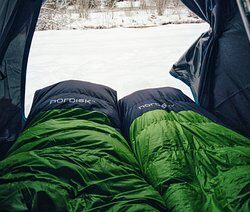You recall times when you grabbed your sleeping bag and made a fort in your living room or stayed at a friend’s house? Roll out the sleeping bag on the floor, and the indoor adventure begins. However, I bet you probably never considered your sleeping bag to be a valuable piece of survival gear.
A sleeping bag is more than just a blanket to roll up in. It is a shelter from the elements that, if used properly, can save your life in extreme cold weather. However, not all bags are created equal. You must match the bag to your outdoor adventure.
Here are a few tips on how to choose the right sleeping bag.
Mummy Sleeping Bag
Anyone who has camped in subzero temperatures will probably agree that a mummy sleeping bag is better suited to keeping you warm. However, some people may find it too constricting. In extreme cold areas, you want as much of your body covered as possible, which includes your head and the sides of your face. Ensure your mummy type bag has a hood that covers your head and face and is adjustable.
You would want the bag to protect you at zero degrees or lower for extreme cold weather adventures. Bags are rated at different temperatures. It is better to have protection below zero even if you do not need it every night.
In the United States, there is no standard for sleeping bag ratings. Unlike Europe, where the EN 13537 standard is used. Because there are no standards, a bag rated for 20oF from one manufacturer in the United States may differ from another manufacturer making the same rating claim.
Check that the bag is large enough to accommodate your body. Mummy bags should have extra material at the feet for warmth and enough room for your feet to not be pressed together. Examine the shoulder space to make sure you can move around or even roll over inside the bag if necessary.
Open Faced
In milder climates, an open faced one or one that unzips into a large blanket, if you will, may be preferable. Use a sleeping pad to give you more comfort from the hard ground.
Filler Types for Sleeping Bag
Down Filling
Goose down is by far the best insulator but when used in a sleeping bag, it has some drawbacks over certain synthetic materials. When wet, goose down has almost no insulating properties. While it has loft, which means it expands to provide air pockets necessary to stay warm throughout the night, the down is easily compacted.
This may cause cold spots unless the bag is of high enough quality that the down is in individual pockets inside the lining. As you lay on it, the pockets keep the goose down from spreading thin.
Down filled bags must be dried properly and not stored rolled up to prevent compacting the down. It would be necessary to have a waterproof sleeping bag cover or Bivy, which can act as a shelter if you do not have a tent to protect you from the elements.
Once the down becomes wet, it must be dried before storing. Most experts would agree sleeping with wet down in cold weather is more dangerous than sleeping without the bag at all because anyone sleeping on damp material can easily succumb to hypothermia.
Synthetic Material
A synthetic material, such as PrimaLoft®, is a microfiber thermal insulator that has similar insulating properties to down. In the 1980s, PrimaLoft was created specifically for the United States Army.
The material is like goose down, but it does not lose its insulating properties when wet. It dries easily, and can be stored tightly rolled up. It is significantly less expensive than goose down.
Because the material does not compact like goose down, it provides more cushioning against the ground and reduces cold spots. However, it is recommended that you use a sleeping mat. Along with any sleeping bag, it provides cushioning and insulation.
Of course, the bag must have a zipper that allows for opening from the inside. The zipper area should be reinforced with a draft tube running the length of the zipper to prevent a “cold zone.”
The bag should include a water-resistant, if not waterproof, carry bag that can be lashed to your pack to keep it dry on rainy hikes. When not in use, the sleeping bag should be able to be rolled up tightly.
In Conclusion
Know the weather in the area where you’ll be hiking or camping, so you can be prepared. A bag that protects you below zero will protect you below zero and above zero, but a bag rated between 32 and 50oF may cause a serious problem if the temperature drops below freezing.
Having the right sleeping bag is essential for outdoor adventures. This article informed you on how to choose the right sleeping bag depending on your location. The right sleeping bag will keep you warm and safe. Follow these suggestions and have a safe and enjoyable adventure.


